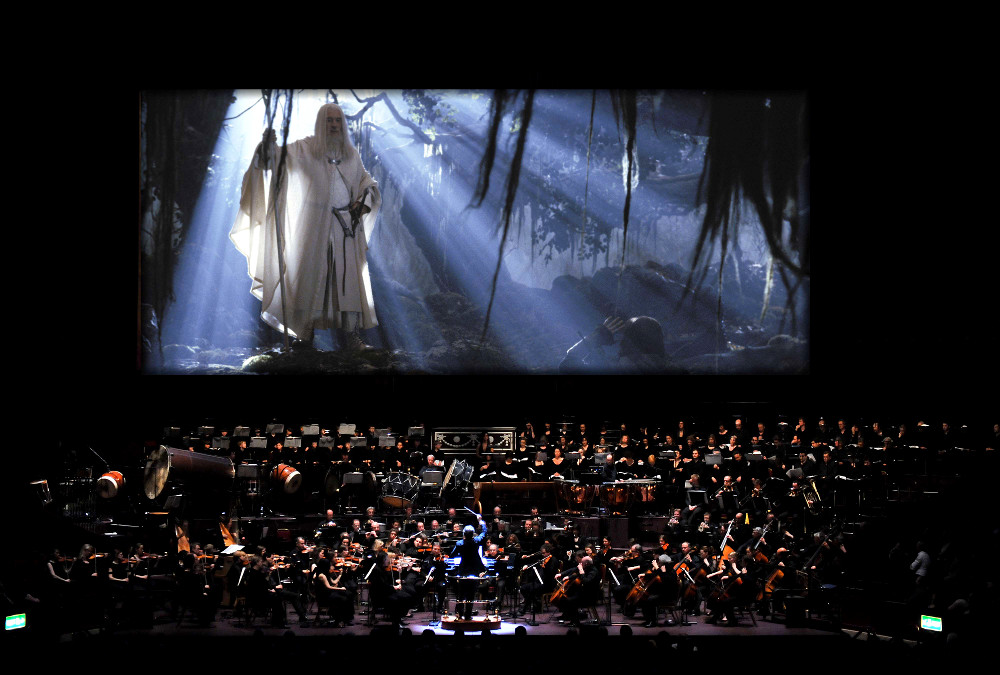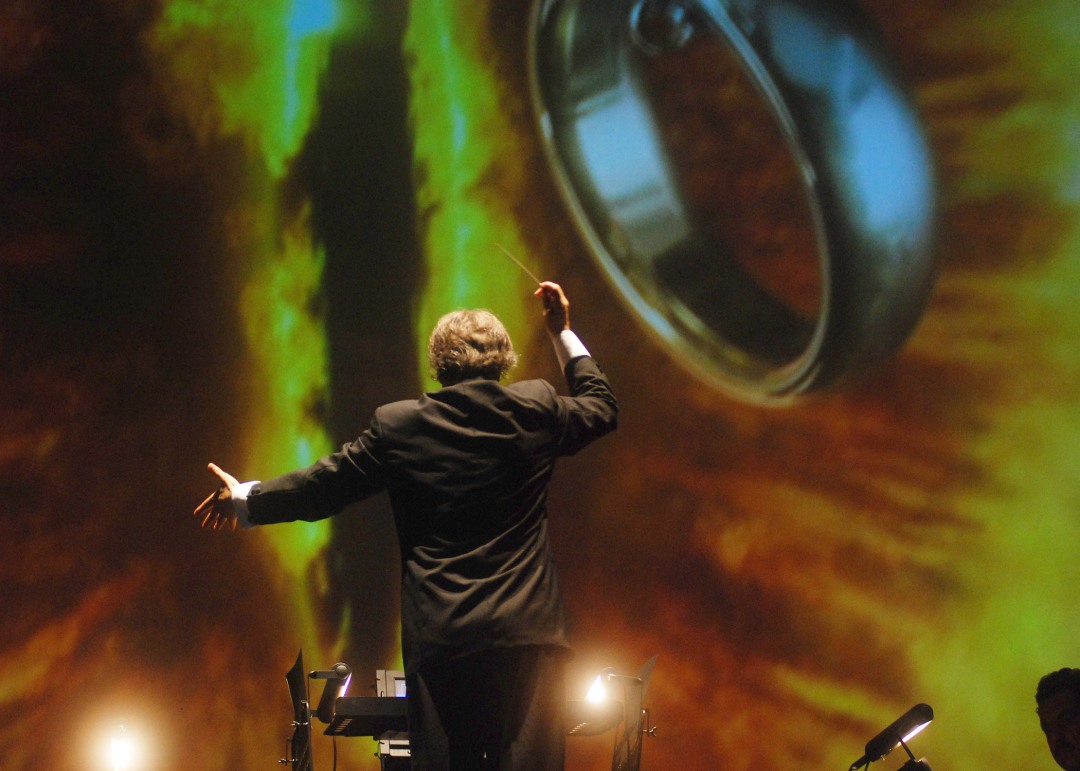Some time ago I read a Silicon Valley Business Journal piece about the Symphony Silicon Valley’s Live-to-Projection Lord of the Rings concerts. SSV President, Andrew Bales, expected to sell out the two full runs of the trilogy in their Center for the Performing Arts in San Jose. This would mean selling out 15,000 seats for the two cycle run, and if an early review in the San Jose Mercury News is any indication (11,000 tickets had already been sold), then it’s like that SSV came close to that goal.

The question is, what exactly did that goal entail? Interestingly, this is one of the very few pieces which reports on projected figures and at least some of the operating costs for a Live-to-Projection event. If all the seats were sold, then the SSV would take in something “do something north of $1 million.” Bales continues “I don’t anticipate losing money.”
In this case, someone is losing money–namely, the musicians. As the SJBJ states:
Each musician took a pay cut of $18 per “service” (a service is a 2.5-hour rehearsal or performance session) to $125 “to help the organization venture into new things and also assume part of the business risk.”
After paying about $225,000 to the orchestra – the first American symphony to play the trilogy – Bales’ second-largest expense will be film royalties to New Line Cinema. He declined to reveal the amount because of a confidentiality clause in the contract, but he said it includes seven of the film company’s employees on site to handle projection and logistical tasks. While Bales valued the time of the 150 unpaid singers from the Symphony Silicon Valley Chorale and Ragazzi Boys Choir at about $100,000, their organizations will receive fees.
In other words, 100 musicians took, roughly, a 13% pay cut and 150 musicians performed unpaid.
As is the case with Film and Video Game properties, there will always be a licensing/royalty fee–especially if live projection is included in the event. And it looks like we can assume the fee mentioned above is somewhere between $225,000 and $100,000 for the film royalties (assuming the $100,000 fees for the choral organizations is actually the third-largest expense).
Whether the Symphony Silicon Valley situation is typical of all live-to-projection events (both film and video game versions) is unclear, but it certainly fits in with some other models of popular entertainment where performers aren’t adequately compensated while profits tend to go elsewhere. It’s also a reflection of how skewed our ideas of profitability are and how that is informed by models in popular entertainment industries which exploit legal and socio-economic loopholes which don’t necessarily benefit certain stakeholders (i.e. performers) within those industries.
The focus on bringing these types of populist events into the regular symphonic repertory also takes the focus off the various Film Score and Video-Game Orchestras which primarily perform these and similar kinds of work–most of which aren’t necessarily doing it in a “profitable” way as they are functioning similarly to the hundreds of smaller budget community orchestras which are usually subsidized by donations of musicians’ time.
I think that we in the arts need to have a discussion of the wider culture of the performing arts to understand how the field actually operates and how some individual organizations evolve into bigger budget organizations (and how others don’t). It’s never simply a question of what’s popular is what sells or is what’s relevant and applying that to the larger budget organizations–especially when we have plenty of smaller and newer organizations regularly doing Film/Video Game events as their standard rep while not transitioning into bigger budget Orchestras despite performing the requisite relevant, populist concerts some have been advocating.



Great post. The quote from the SJBJ tells you everything you need to know:
“Each musician took a pay cut of $18 per ‘service’ (a service is a 2.5-hour rehearsal or performance session) to $125 ‘to help the organization venture into new things and also assume part of the business risk.'”
If they “assume part of the business risk,” then they should share the spoils of victory! I love the idea of film and video game nights for orchestras, from time to time. But if the musicians end up subsidizing the costs of the performance, then it was set up wrong to begin with.
Live-to-projection events like this hint at all the possibilities for novel, one-off performances that may attract new classical concert-goers. It’s crucial for the live orchestral experience to evolve. But even great media coverage, and flawless execution, can’t hide the shoddy arrangements it took to get there.
LikeLike
Right–when I first read that back in April I was wondering how often these kinds of cuts and unpaid labor happen for the big live-to-projection events. And spot on–if they assume some of the business risk, then they should share the rewards.
I can actually imagine a number of ways of making these kinds of things profitable–while also benefiting the musicians. After all, it’s similar to how other pop entertainment orgs create events while subsidizing the operating costs with non-performance revenue.
An aside–I would love to see orchestras working with their local filmakers/composers to create live-to-projection events which feature local content. I know this isn’t necessarily a way to generate the kind of revenue I think orchestras are looking for with the LTP shows, on the other hand, the licensing costs would be significantly lower, and building goodwill and embedding into the local arts communities in this way might be a way to offset any initial losses. It’d be an investment–and a valuable one at that.
LikeLike
I like the idea of tying in local films/filmmakers for performances. It would be less of a financial hit than a blockbuster like LOTR. Plus, it helps seed the local arts scene, establishes your orchestra as filmmakers’ first option for non-traditional shows, and taps a different audience than your typical Saturday night symphony crowd.
I hadn’t considered revenue outside of performance. Not sure what kinds of merchandise they could sell as part of a LOTR performance. But they could also do food/drink promotions, partnerships with bookstores to sell Tolkien’s books… things like that.
Love the blog, keep up the good work!
LikeLike
I’ve always wished US orchestras would focus more on local content. Especially now when we’re in an age that livecasts are a thing. If someone can see the Berlin Phil or New York Phil play Beethoven 5, how likely are they to see the local orchestra play it? Sure, livecast technology still has a long way to go, but it’s to the point that we can see the livecasts in the comfort of our own home theaters.
Focusing on local content, especially if that content is unavailable anywhere else, would create a completely different “product” and would allow any local orchestra doing that to be unique. Even if every orchestra did things like this, each would be different if only because of the local composers and/or filmakers.
The merchandising (and licensing) thing is something that isn’t often looked at by both critics and the naysayers in the Classical World. Case in point–around the time Symphony of the Goddesses did that performance on the Colbert show live, there were a spate of articles talking about how Video Game Music will save Orchestras (here’s one. Sadly, the one in the Wall Street Journal is now behind a paywall, but it talked about the many thousands of merch that was sold at the SoG shows. Which underscores the fact that the SoG is also produced and sponsored by Nintendo. In a way, those concerts function as live advertisement for the Nintendo brand, as well as merch. Also, the SoG is a touring orchestra, not a project like the LOTR live-to-projection event above.
It’s unclear that a local orchestra would be able to come out in the black if it were to do the production and pay the licensing fee (if the SoG show is even open for licensing outside of the house touring orchestra). And the merch sales obviously aren’t going to the musicians–they go to Nintendo as a way to help recoup their costs of funding the tour. It would be interesting to see whether Nintendo and the SoG actually recoup all the operating costs of their tour with ticket sales + merch sales, but I imagine that’s not the point. It’s partly a marketing campaign for the Nintendo brand, and especially the Zelda games. This isn’t a whole lot different than television advertisements and how they function. When corporations are willing to spend millions on ads during the SuperBowl, that’s part of building (or maintaining) their brand which is part of a longterm solution for the companies. They’re not looking for a direct Return on Investment as obviously most television ads aren’t direct marketing techniques.
The question is, can orchestras (or other big classical music institutions) actually benefit from similar economic models as popular entertainment industries in the same way that those industries are benefiting from those models? Or, are those models too industry specific a solution to work for what are essentially non-profits/not-for-profit organizations.
LikeLike
Oh, and thanks–glad you’re enjoying the blog!
LikeLike